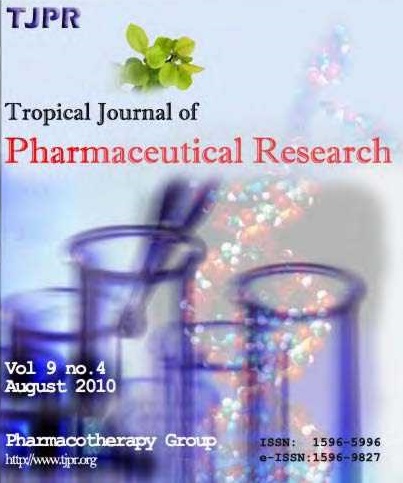[lt;i>;] [i>]乙醇提取物对秀丽隐杆线虫伤害性的影响</i>模型
IF 0.6
4区 医学
Q4 PHARMACOLOGY & PHARMACY
引用次数: 0
摘要
目的:采用秀丽隐杆线虫模型,研究枳实乙醇提取物(ANEE)的抗伤性作用。方法:采用亚致死法对ANEE进行亚致死实验,确定实验浓度,用于抗刺激实验。在72小时内的4个治疗时间点,采用力学感觉法研究了ANEE对秀丽隐杆线虫的抗伤害感受作用。计算ANEE细胞以及吗啡、扑热息痛和对照(1% DMSO)处理的细胞的抗伤害指数(antiinociceptive index, AI)。结果:机械感觉实验结果显示,ANEE(104、103、102 μg/mL)的抗伤感觉指数(AI)显著高于对照(1% DMSO)。ANEE、2.5 μM吗啡和0.01% mg/mL扑热息痛对秀丽隐杆线虫的抗伤感受作用差异无统计学意义(p>0.05)。在72小时内进行四次治疗后,ANEE的效果仍在继续。结论:野刺草乙醇提取物(ANEE)具有抗伤性作用,证实了野刺草的民间用途,并提示其具有慢性治疗的潜力。本文章由计算机程序翻译,如有差异,请以英文原文为准。
Effect of <i>Asplenium nidus</i> ethanolic extract on nociception using a <i>Caenorhabditis elegans</i> model
Purpose: To investigate the antinociceptive effect of Asplenium nidus ethanolic extract (ANEE) using a Caenorhabditis elegans model.Methods: Sublethality assay was performed on ANEE to determine the experimental concentrations to be used for the antinociceptive assays. Antinociceptive effect of ANEE in C. elegans was investigated using mechanosensation assays in four treatment timepoints within 72 hours. Antinociceptive index (AI) was calculated for the cells treated with ANEE cells as well as morphine, paracetamol and control (1% DMSO).Results: The mechanosensation assays revealed that ANEE (104, 103, 102 μg/mL) had a significantly higher antinociceptive index (AI) (p<0.05) compared to the vehicle control (1% DMSO). The antinociceptive effects of ANEE, 2.5 μM morphine, and 0.01% mg/mL paracetamol in C. elegans were not significantly different (p>0.05). This effect of ANEE continued after four treatments within a 72-hour period.Conclusion: The findings revealed that A. nidus ethanolic extract (ANEE) possesses antinociceptive effect which validates folkloric use of A. nidus and suggest a potential for chronic therapeutic use.
求助全文
通过发布文献求助,成功后即可免费获取论文全文。
去求助
来源期刊
CiteScore
1.00
自引率
33.30%
发文量
490
审稿时长
4-8 weeks
期刊介绍:
We seek to encourage pharmaceutical and allied research of tropical and international relevance and to foster multidisciplinary research and collaboration among scientists, the pharmaceutical industry and the healthcare professionals.
We publish articles in pharmaceutical sciences and related disciplines (including biotechnology, cell and molecular biology, drug utilization including adverse drug events, medical and other life sciences, and related engineering fields). Although primarily devoted to original research papers, we welcome reviews on current topics of special interest and relevance.

 求助内容:
求助内容: 应助结果提醒方式:
应助结果提醒方式:


